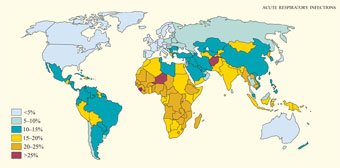Communicable Diseases Module: 35. Acute Respiratory Tract Infections
Study Session 35 Acute Respiratory Tract Infections
Introduction
In this study session, you will learn about acute respiratory tract infections (ARIs). The respiratory tract (or ‘airways’) includes all the parts of the body that enable us to breathe. ARIs are infections of the respiratory tract by either bacteria or viruses, and the term ‘acute’ indicates that the illness is of short duration (less than two weeks). ARIs are the leading cause of illness and death among young children everywhere in the developing world (Figure 35.1). Ethiopian children suffer four to eight episodes of ARI on average every year, with the highest occurrence in urban areas in overcrowded living conditions. In rural Ethiopia, 20% of the deaths of children aged under five years and more than 30% of the infant deaths under one year are due to ARIs. A better knowledge of ARIs will enable you to detect children with an ARI more quickly and give appropriate treatment, or refer them if the disease is severe.

